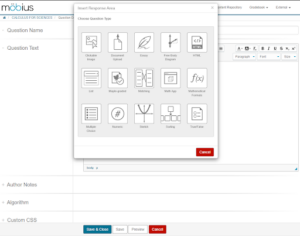So you’re not a brilliant coder—or even an entry-level one—but it seems like to be able to gather a decent repository of online STEM questions to call your own, you need to know algorithmic syntax, or use LaTeX, or be comfortable in some other coding language. There’s got to be an easier way to generate questions that keep your students engaged and on track with learning objectives! Lean on Möbius for delivering 15 different types of STEM-focused questions, plus an impressive array of associated sub-types that go way beyond a traditional and predictable multiple choice question. With the wide range of code-free Möbius question authoring options, you don’t need to sacrifice complexity for feasibility.

Of course there’s nothing wrong with a good old multiple choice question, and in fact, Möbius proudly boasts this question type! It’s just that you don’t need to settle when it comes to Möbius questions just because you don’t feel comfortable with or have time for working on back-end coding.
Using Möbius’ Question Editor, you can start from a blank slate and forge the perfect question without touching code:
- Display visually accurate and natural-looking mathematical notation using a symbolic point-and-click Equation Editor.
- Have fine-grain control over a ton of your question’s properties like partial grading, grading tolerances, permitted student input modes, available answer choices, and more.
- Engineer hints and feedback that your students can access during their attempts at your questions to solidify their comprehension.
- Deliver intelligent questions that innately detect response equivalency (for example, both 1 metre and 100 centimetres would be accepted; unless you define otherwise).
- Transform static questions into endlessly algorithmic versions with the Algorithm Designer.
- Combine different question types to form adaptive questions that navigate students through question paths based on their response correctness.
- Liberate the artist in you by handling all of your questions’s aesthetics like fonts, colours, sizing, layouts, the inclusion of multimedia, and many other styling aspects.
That’s a lot of question-authoring tasks that can be accomplished code-free.
In addition to the trusted multiple choice question and the available multiple selection sub-type, other classic and dependable question types are super quick to author in Möbius without coding:
Some other honourable mentions that Möbius offers that are also fast and easy to build without coding are:
- Clickable Image: students click on image hotspots;
- Document Upload: view offline portions of a student’s response;
- Essay: students can provide a long answer response and even insert sophisticated math notation using a point-and-click Equation Editor (with access to LaTeX, themselves, if they want!);
- Free Body Diagram: students work with click-and-drag forces on control points;
- Mathematical Formula: choose from 10 sub-types to define the type of accepted student expressions;
- Numerical: students enter a number value that can include units of measure; and
- Sketching: test your students’ plotting abilities with a click-and-drag Sketch Board.
There you have it! Already 12 excellent options (and don’t forget about all of the sub-types) that you can author from scratch without needing to be a programmer, enabling you to ask interesting STEM-focused questions with minimal authoring demands.
What about the other three question types?
True, these last three question types are authored with code, but that doesn’t mean you can’t leverage them! You can copy—and even edit—these and other sophisticated, expert-authored, pre-built questions from the Möbius Content Packs and Content Templates to make them yours!
The Möbius Online Help is a highly detailed resource to guide you through code-free Möbius question authoring, editing, and importing the 15 Möbius question types plus algorithms, and when you’re ready to explore how to use code to author your own more elaborate and robust questions, or be ingenious with your algorithms, give QUESTION AUTHORING PART II: Get Coding a read.

